|
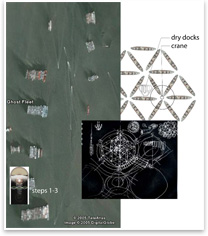 Water World: From Toxic Scrap to Harmonious Village Water World: From Toxic Scrap to Harmonious Village
by Heather Livingston
Contributing Editor
Summary: The U.S. federal government has a big problem moored on the James River near Fort Eustis in Newport News, Va. David Phillip Walen, an architect in Charleston, S.C., has a solution, albeit an unlikely one given its necessary capital investment.
The National Defense Reserve Fleet, nicknamed the Ghost Fleet, is a retired collection of inactive military, merchant, and commercial ships that are under the purview of the U.S. Department of Transportation Maritime Administration (MARAD). According to Globalsecurity.org, the reserve fleet, which is moored at three separate locations around the U.S., can potentially be reactivated in between 20-120 days to meet needs of our government in a time of crisis. Unfortunately, the fleet is “an environmental disaster waiting to happen,” said the late Virginia Congresswoman Jo Ann Davis.
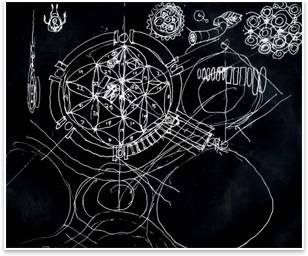 An article from the Daily Press newspaper in Virginia Beach noted that although a number of the ships are in near-ready condition, approximately two dozen “need to be scrapped as soon as possible … Salt water has eaten away at the hulls through the years. In some, there are thumb-sized dimples where the steel hulls have thinned and pose the risk of an oil leak.” This was in 2002. Over the years, various efforts have been made to scrap the ships in the worst condition, including one endeavor which sent a number of the ships to a scrap yard in England, only to be denied entry and returned to the James River. Because of the toxic nature of the ships’ building materials—including asbestos, PCBs, oil, and other industrial contents—strict EPA regulations determine how the ships are to be dismantled, making it highly difficult for a shipyard to meet the requirements. This is where David Phillip Walen’s solution comes in. An article from the Daily Press newspaper in Virginia Beach noted that although a number of the ships are in near-ready condition, approximately two dozen “need to be scrapped as soon as possible … Salt water has eaten away at the hulls through the years. In some, there are thumb-sized dimples where the steel hulls have thinned and pose the risk of an oil leak.” This was in 2002. Over the years, various efforts have been made to scrap the ships in the worst condition, including one endeavor which sent a number of the ships to a scrap yard in England, only to be denied entry and returned to the James River. Because of the toxic nature of the ships’ building materials—including asbestos, PCBs, oil, and other industrial contents—strict EPA regulations determine how the ships are to be dismantled, making it highly difficult for a shipyard to meet the requirements. This is where David Phillip Walen’s solution comes in.
Forming a floating village
Walen has proposed that the ships be remediated and restored to full functionality and linked together to form a floating village that could sustain human life offshore. “I think it would be a great way to take something that people only want to scrap and use this as the seed for something that would demonstrate a radically different way of human habitat,” Walen explains.
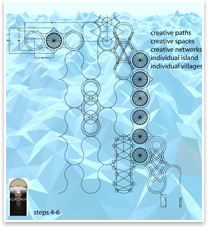 Walen first became interested in the idea after his father sent him an article on the Ghost Fleet, but Walen says that his inspiration to design a floating city comes from a sense of wanderlust. “I think a lot of people want to travel around the world and work and live,” he elaborates. “I’ve moved so many times myself in the past that thinking of a way to be a modern gypsy is kind of a path plan. How do you carry all those things that you need to engage your world? How do you transport, for example, a wood shop or a metal shop? You need a village, but how do you travel and still have a home is the dilemma that drove me to the fantasy where you’d be a gypsy with a city that you could walk with, a kind of Archigram walking city, but a floating city.” Walen first became interested in the idea after his father sent him an article on the Ghost Fleet, but Walen says that his inspiration to design a floating city comes from a sense of wanderlust. “I think a lot of people want to travel around the world and work and live,” he elaborates. “I’ve moved so many times myself in the past that thinking of a way to be a modern gypsy is kind of a path plan. How do you carry all those things that you need to engage your world? How do you transport, for example, a wood shop or a metal shop? You need a village, but how do you travel and still have a home is the dilemma that drove me to the fantasy where you’d be a gypsy with a city that you could walk with, a kind of Archigram walking city, but a floating city.”
Walen’s idea is to determine which ships are salvageable first and then “basically form a platform that would be used to recycle the ships,” tethering the ships together to create permanent islands capable of traveling around the world and potentially demonstrating a better way to live. Walen believes that retrofitting the ships to usability could employ and test a number of newer technologies like mycology remediation (using mushrooms to cleanse toxic debris), foam Asbestos containment and elimination, (potentially even used in the foam as future floatation or insulation), bacteria that eat waste, and perhaps nanotechnology.
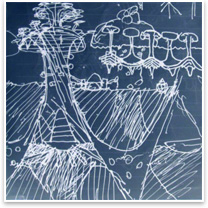 Networked “islands” Networked “islands”
Once the ships are made functional and habitable, the next step would be to create “intentionally unique villages, each uniformly shaped to allow networked arrangements. One island could function autonomously, but, the dynamics of networking these islands would create an ever transforming environment.” Ideally the floating islands would have greenhouses, workshops, shared kitchens, and storage holds. The various uses of the central sphere would serve the collective need of the networked islands through restaurants, agriculture, manufacture, repair, etc. In addition, Walen explains that the unique tethering system would allow for quick and easy disassembly and reformation to suit the needs of the crew/residents and allow it to fit into any port.
“There are many examples of similar ideas [such as] pitching the islands as a vacation paradise,” says Walen. “However, my tack is that these islands should be looked at not as escapes, but as solutions to our need to be social [and] live adventurously, while using a balance with nature to survive. The statements ‘all waste is kept healthy’ and ‘followed around the world by the life that feeds the people, the city feeds’ are crucial mantras. They point out that this idea (of living cities) must be beneficial to the sea life as well as the humans. If these ideas start catching on and people start making them, it could save the human race or destroy it. If the ocean were covered with vacation paradise islands, behaving like tourist [and] throwing waste overboard or relying on importing electricity and food, the pressure on the land connections and the damage to the environment could be worsened. If these islands are built in ways that don’t use resources on land to survive (instead of adding pressure on sea life, it fosters it), the ocean, which is 75 percent of our planet, could allow humanity a way to continue to grow in harmony.”
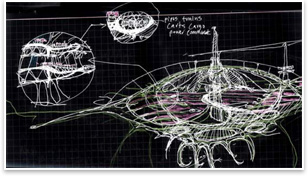 Walen does concede that the cost to achieve his proposal would be astronomically expensive, probably exceeding a billion dollars by his estimate. However, the cost to simply scrap only one of these ships is easily $500,000, and until a resolution is finally brokered, the ships will continue to leach their toxic contents into the James River estuary. Walen does concede that the cost to achieve his proposal would be astronomically expensive, probably exceeding a billion dollars by his estimate. However, the cost to simply scrap only one of these ships is easily $500,000, and until a resolution is finally brokered, the ships will continue to leach their toxic contents into the James River estuary.
|



